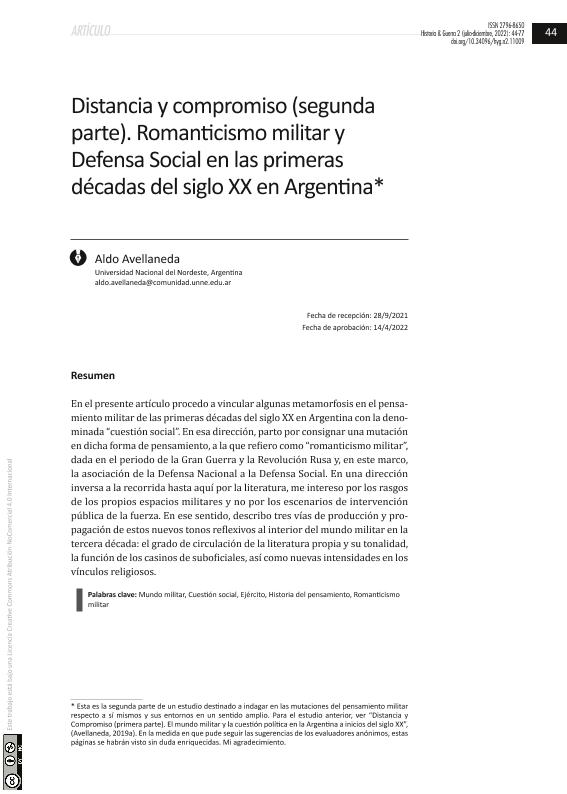Mostrar el registro sencillo del ítem
dc.contributor.author
Avellaneda, Aldo Nicolás

dc.date.available
2023-08-31T11:37:50Z
dc.date.issued
2022-11
dc.identifier.citation
Avellaneda, Aldo Nicolás; Distancia y compromiso (segunda parte): Romanticismo militar y Defensa Social en las primeras décadas del siglo XX en Argentina; Universidad de Buenos Aires. Facultad de Filosofía y Letras. Instituto de Historia Argentina y Americana “Dr. Emilio Ravignani"; Historia & Guerra; 2; 11-2022; 44-77
dc.identifier.issn
2796-8650
dc.identifier.uri
http://hdl.handle.net/11336/210007
dc.description.abstract
En el presente artículo procedo a vincular algunas metamorfosis en el pensamiento militar de las primeras décadas del siglo XX en Argentina con la denominada “cuestión social”. En esa dirección, parto por consignar una mutación en dicha forma de pensamiento, a la que refiero como “romanticismo militar”, dada en el periodo de la Gran Guerra y la Revolución Rusa y, en este marco,la asociación de la Defensa Nacional a la Defensa Social. En una dirección inversa a la recorrida hasta aquí por la literatura, me intereso por los rasgos de los propios espacios militares y no por los escenarios de intervención pública de la fuerza. En ese sentido, describo tres vías de producción y propagación de estos nuevos tonos reflexivos al interior del mundo militar en la tercera década: el grado de circulación de la literatura propia y su tonalidad, la función de los casinos de suboficiales, así como nuevas intensidades en los vínculos religiosos.
dc.description.abstract
This article links some metamorphoses in the military thought of the first decades of the 20th century in Argentina with the so-called “social question”. In this direction, I start by consigning a mutation in this way of Thought, which I refer to as “military romanticism”, given in the period of the Great War and the Russian Revolution and, in this framework, the association of “National Defense” to the “Social Defense”. In contrast to the one covered up to now by the literature, I am interested in the features of the military spaces themselves and not in the scenarios of public interventions. In this sense, I describe three routes of production and propagation of these new reflective tones within the military world in the third decade: the degree of circulation of own literature and its tonality, the function of the NCO Casinos, and new intensities in the religious ties.
dc.format
application/pdf
dc.language.iso
spa
dc.publisher
Universidad de Buenos Aires. Facultad de Filosofía y Letras. Instituto de Historia Argentina y Americana “Dr. Emilio Ravignani"
dc.rights
info:eu-repo/semantics/openAccess
dc.rights.uri
https://creativecommons.org/licenses/by-nc/2.5/ar/
dc.subject
MUNDO MILITAR
dc.subject
CUESTIÓN SOCIAL
dc.subject
PENSAMIENTO
dc.subject
GUERRA
dc.subject.classification
Otras Historia y Arqueología

dc.subject.classification
Historia y Arqueología

dc.subject.classification
HUMANIDADES

dc.title
Distancia y compromiso (segunda parte): Romanticismo militar y Defensa Social en las primeras décadas del siglo XX en Argentina
dc.title
Involvement and Detachment (Second Part): Military romanticism and Social Defense in the first decades of the 20th century in Argentina
dc.type
info:eu-repo/semantics/article
dc.type
info:ar-repo/semantics/artículo
dc.type
info:eu-repo/semantics/publishedVersion
dc.date.updated
2023-07-07T19:24:45Z
dc.journal.number
2
dc.journal.pagination
44-77
dc.journal.pais
Argentina

dc.description.fil
Fil: Avellaneda, Aldo Nicolás. Consejo Nacional de Investigaciones Científicas y Técnicas. Centro Científico Tecnológico Conicet - Nordeste. Instituto de Investigaciones Geohistóricas. Universidad Nacional del Nordeste. Instituto de Investigaciones Geohistóricas; Argentina
dc.journal.title
Historia & Guerra
dc.relation.alternativeid
info:eu-repo/semantics/altIdentifier/url/http://revistascientificas.filo.uba.ar/index.php/historiayguerra/article/view/11009
dc.relation.alternativeid
info:eu-repo/semantics/altIdentifier/doi/https://doi.org/10.34096/hyg.n2.11009
Archivos asociados
